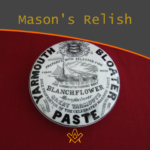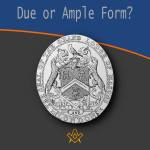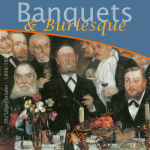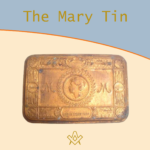This detective story began with the purchase of the medal part of a Royal Arch Centenary Jewel on eBay assigned to Chapter of Charity No 187 and dated 1769 (presumably struck after 1869). The hallmark was for 1882 but the inscription on the reverse said, ‘Companion William Holroyd Price’. Could this man be Dr William Price, a Son of Wales, a Freemason? The seller’s description suggested so!

Initial searches via Quatuor Coronati confirmed no references to a brother by this name in their records. A later enquiry to the Library and Museum of United Grand Lodge of England in London also confirmed that they had no references to him.
So, the trail then ran back to the seller of the jewel who said it had come from her grandfather, who presumably knew Price through his Masonic activities.
Contact followed with the Provincial Grand Lodge of South Wales and the Secretaries and Scribe E’s of various lodges and chapters and in particular the Chapter of Charity.
The trail looked extremely good, and it was likely this was a lost Mason for whom history had dealt an interesting hand. However, soon afterwards the train hit the buffers when the Scribe E of Chapter No 189 confirmed that from their extant records a William Holroyd Price had been exalted to that chapter in 1882, a 36-year-old “surveyor of taxes”.
Unfortunate as it was, the Masonic connection had ended in frustration, but nonetheless a very interesting story of an eccentric Welshman was revealed. No doubt had Dr William Price been so minded, being socially conscious and charitable, he would have made a good Mason. However, his place in the history of cremations in Britain was to be secured.
In 1882, the Council of the Cremation Society was requested by Captain Hanham of Blandford, Dorset, to cremate two deceased members of his family who had left expressed instructions to that effect.
The Home Secretary repeated his previous objections, and the Society was thus unable to comply with the request. Captain Hanham, undeterred, consequently erected a crematorium on his own estate and proceeded to cremate his wife and mother on 8th and 9th October that year.
Captain Hanham himself died about a year later and was also cremated there. These events excited much comment in the Press, but the Home Office took no action.
In 1885, the first official cremation took place at Woking, followed by a further ten in 1886. From 1892 to 1896 crematoriums opened in Manchester, Glasgow, and Liverpool. So, it became a necessity for the Government of the day to clarify the law regarding cremations.
The crematorium in Woking was founded in 1878, when a piece of land close to St John’s Village was bought by Sir Henry Thompson. He was a surgeon and Physician to Queen Victoria. In 1874, he was a foremost founder and first president of the Cremation Society of Great Britain.
The land on which the crematorium was to be established was purchased with the aid of subscriptions (at £200 each) from the London Necropolis Company.
It was both secluded yet readily accessible, as a train service, suitable for the conveyance of the dead, already ran between London Waterloo Station and Woking.
The new crematorium was first tested on 17 March 1879, when the body of a horse was cremated. The inhabitants of Woking showed strong antipathy to the crematorium and appealed to the Home Secretary to prohibit the use of the building.
As will be seen later this cremation was declared legal in February 1884, co-incidentally during Dr. William Price’s trial, and the Woking facility allowed to operate.
Thus, on 26 March 1885, the first official cremation in the UK took place in Woking. The deceased was Mrs Jeannette C. Pickersgill, whom The Times described as “a well-known figure in literary and scientific circles”.
The Cremation Society of Great Britain then oversaw two more cremations, a total of three, that year. Some 7 years on, in 1892, 104 cremations were carried out at Woking and by 1902 the first crematorium was opened in London (Golders Green Crematorium).
Elected president of the Cremation Society in 1921, the 11th Duke of Bedford had the original cremator from Woking transferred to a new chapel at Golders Green Crematorium, where it was later used for his own cremation in 1940.
Eventually 1902 became memorable because it was in this year that there was passed an Act of Parliament for the Regulation of burning of human remains, and to enable burial authorities to establish crematoria.
Cremation had achieved a form of governmental regulation and it thereby became officially recognised in the highest quarters. Parliament, having given its formal sanction to cremation in 1902, had the backing of the Church of England.
It argued there were no theological problems with cremation as no variation in the form of burial could affect the resurrection of the body.
In 1910, however, the Dean and Chapter of Westminster Abbey insisted that Sir Joseph Hooker’s remains be cremated if he were to be interned there. All subsequent burials at the Abbey have been of cremated remains.
But what happened in Wales in the early 1880s and prior to the Parliament Act?
In 1821, William Price, the Doctor, a Druid, a Chartist, and a Social Reformer, was one of the youngest doctors to be invited to be made a member of the Royal College of Surgeons having studied at the London Hospital Whitechapel and St Bartholomew’s.
Previously having been brought up in a poor district he was sent to school in Machen. At the age of thirteen he became an apprentice to surgeon/apothecary Doctor Evan Edwards of Caerphilly where he learned the basics of running a medical practise.
He later, on returning to Wales, opened a surgery near Pontypridd in 1823 and was elected chief surgeon for the Brown Lennox chainworks where he remained for almost 50 years.

A photograph of Price taken while he was on stage in 1884, displaying some of his Druidic attire. Image: National Library of Wales.
IMAGE LINKED: wikimedia Attribution 4.0 International (CC BY 4.0)
Near Pontypridd Common is the famous rocking stone, a popular spot for many followers of druidism; the locals of that sect practising their often-bizarre rituals.
He refused to treat smokers and remained a strict vegetarian whilst also condemning many of the practises of his fellow physicians.
He was a keen supporter of the Chartists and probably a prominent organiser which in due course led to the Newport Uprising, which resulted in twenty deaths.
Although it is thought that Price did not attend it has to be noted that he was so involved that he thought it necessary to leave the country, fleeing to France, for a period of time.
The Chartists were determined to see the Peoples Charter of 1838 enacted and their modus operandi was not dissimilar to that of the later Suffragettes at the turn of the Century.
His social reformist credentials were thereby established, and he became well known as a philanthropist with a deep desire to support social and political reform. He attempted to set up a co-operative in Wales but sadly that failed within two years after offering too much credit to striking miners.

William Price of Llantrisant, in druidic costume, with goats. Oil painting by A C Hemming, 1918.
IMAGE LINKED: wellcome collection Attribution 4.0 International (CC BY 4.0)
As with any ‘Son’ Price had his eccentricities. The most bizarre being his robes and costumes, always topped off with a headdress made of a whole fox skin including the head.
Dr Price had three legitimate children, and at least one illegitimate: Iesu Grist (died 1884, cremated), Hiarlles, Iesu Grist II (renamed Nicholas) and Penelopen.
The first child was born on the 8 August 1883, to his wife Gwenllian after he had dreamed of a god-like son whom he blasphemously named Iesu Grist (Welsh: Jesus Christ).
However, the child on lived for five months and Price, sticking to his belief that nothing should contaminate the soil, and no doubt distressed by the death of son, decided to carry out a cremation.
Price claimed to be a Druid High Priest and often performed rites dressed in a white tunic over green trousers. He planned to cremate his son on the hilltop of East Caerans above Llantrisant on 13 January 1884, using a paraffin cask adapted for the purpose.
On the evening, two local colliers saw smoke rising from the hill and, with the local constabulary, intervened before it was completed.
Price was arrested for the violation of a corpse by cremation and possibly the serious crime of infanticide. An inquest was subsequently held, which showed that the child had probably died from convulsions; the coroner returned a verdict of death from natural causes.
However, although Price was cleared of the charge of infanticide, he still faced the other charge of ‘illegal disposition of a body’.
His trial at Glamorganshire Assizes in Cardiff was held on Tuesday 12 February, and Price was charged with causing a public nuisance by cremating a baby who had not been registered before an inquest could be held.
Dr Price, in defending himself brilliantly proclaimed, “it is not right that a carcass should be allowed to rot and decompose in this way, with the resultant wastage of good land, pollution of earth and water and air and a constant danger to all living creatures”.
Following the two-day trial, he was discharged. The result of the trial led to the breakthrough the Cremation Society had been waiting for. Mr. Justice Stephen delivered his all-important pronouncement that cremation is legal provided no nuisance is caused in the process to others.
Price tried to claim 3,000 guineas damages against the police for preventing the completion of his son’s cremation. He was awarded the nominal sum of one farthing.
Price successfully cremated the remains on 14 March and commemorated it by having 3000 oval shaped medals struck in bronze, which he sold at 3d each – a not insignificant amount in those days, and no doubt recouping his legal costs!

William Price’s Cremation Memorial Tokens the inscription reads: “See Jesus Christ from the fire dragging In the hand of Victoria, my dear Welshman, In the presence of the Day of Judgement he owns the sword Of the Prince of Love, and the Crown of Wales. January 13 1884”.
IMAGE LINKED: https://rarecoinsandtokens.co.uk/ Attribution 4.0 International (CC BY 4.0)
In 1893, at the grand age of ninety-three, Price lay dying and was asked if he would take some cider, he responded, “No, give me champagne”.
After taking a sip, he closed his eyes and died. Gwenllian was determined to carry out his final wishes on how to dispose of his body and so the first pre-arranged cremation in Wales took place.
It was on East Caerlan fields and admission tickets were issued for this main event on the 21 January 1893. People began arriving as early as 4 a.m. and by the time of the funeral it was estimated 20,000 people were in Llantrisant where a carnival mood prevailed, and the pubs ran dry.
Dr William Price had hoped that Llantrisant would be the location of the first fully functional crematorium in Wales, but it was not to be. Glyntaff, the town of his former surgery, was to have that honour; nearby is Pontypridd, the site of the Druid’s rocking stone.

William Price. Colour lithograph by Newman & Co, 1861, after J. Jacquier.
IMAGE LINKED: wellcome collection Attribution 4.0 International (CC BY 4.0)
So, William Price a romantic eccentric to the end, became a True Son of Wales.
Every mortal will encounter the prospect of futurity. In Masonic terms it is brought into focus in the ceremony of the Third degree, the ‘raising’ of a Master Mason, when the candidate is invited to reflect on the awesome subject of death. But, having symbolically re-enacted the colourful character of Hiram Abif, the candidate is happily reunited with the brothers of his labours.
Perhaps this is best taken as a practise – or rehearsal – for the real event at the end of a brother’s passage on this Earth.
Death is a funny thing!
Article by: Paul Gardner

Paul was Initiated into the Vale of Beck Lodge No 6283 (UGLE) in the Province of West Kent, England serving virtually continuously in Office and occupying the WM Chair on three occasions.
Paul joined Stability Lodge No 217 in 1997 (UGLE) and now resides with Kent Lodge No 15, (UGLE) the oldest Atholl Lodge with continuous working since 1752, where he was Secretary and now Assistant Secretary and archivist, having been WM in 2002.
In Holy Royal Arch he is active in No 15 Chapter and Treasurer of No 1601, which was the first UGLE Universities Scheme Chapter in 2015.
He was Secretary of the Association of Atholl Lodges which maintains the heritage of the remaining 124 lodges holding ‘Antients’ Warrants and has written a book on Laurence Dermott. - https://antients.org

Dr William Price: Wales’s First Radical
By: Dean Powell
Chartist, surgeon, heretic, Archdruid and pioneer in the legalisation of cremation in the British Isles, Dr William Price was undoubtedly one of the most flamboyant, romantic and eccentric characters in Welsh history.
Famed healer, crusader of reform, exiled political activist and a sparkling, dynamic, eloquent man who blazed progress and controversy by outraging a conventional society, there was much more to Price than his radical attitudes to cremation.
Poverty-stricken in his youth, and with an insane priest for a father, Price remarkably still became a surgeon by the age of just twenty-one.
He created an embryonic national health service, masterminded the first Museum of Welsh Life, launched Britain’s first co-operative society, had visions of a new massed druidic rising and was exiled to France as a Chartist leader.
Calling his first son Jesus Christ Price, claiming he was a druidic Messiah, he cremated the child after its death aged just five months.
The landmark court case led to the passing of the Cremation Act in 1902. He fathered illegitimate children with a housekeeper sixty years his junior and died sipping a glass of champagne at the age of ninety-three.
This is the first fully researched biography of Dr Price, capturing not only his life’s history but also the thoughts and ideals of the man himself.
It includes a vast collection of pictures, private letters and family papers never used in any previous publications.
Recent Articles: by Paul Gardner
 Exchanged the Sceptre for the Trowel Explore the intriguing history of Royals and Freemasonry following the new Monarch's Coronation. From Prince Albert's initiation to the influence of George II and beyond, discover why royalty has long exchanged the sceptre for the trowel, shaping society and maintaining power through this ancient craft. |
 Unearth the mystic origins of Freemasonry in 'That He May Be Crafted.' Paul Gardner explores the symbolic use of working tools from the earliest days of this secret society, revealing a time when only two degrees existed. Delve into this fascinating study of historical rituals and their modern relevance. |
 Paul Gardner looks to a time when politics and Masonry were not precluded, but shush! This was London Masons and the Spitalfields Act of 1773-1865. |
 That rank is but the guinea’s stamp, the man himself’s the gold. But what does this mean, even given the lyric and tone of Burns’ time? It is oft times used in a derogatory sense, (somewhat in good humour) between Masons (or not) on the achieving of honours. But its antecedents are much more complex than that. |
 John and Timothy Coleman Blanchflower were initiated in Walpole Lodge, No. 1500, Norwich England on 2 December 1875; noted as a purveyor of ‘sauce’ to masons! |
 Jacob’s Ladder occupies a conspicuous place among the symbols of Freemasonry being on the First Degree Tracing Board, the most conspicuous and first seen by the candidate on his initiation – a vision of beauty and intrigue for the newly admitted. |
 During a detective hunt for the owner of a Masonic jewel, Paul Gardner discovered the extraordinary life of a true eccentric: Dr William Price, a Son of Wales, and a pioneer of cremation in Great Britain. Article by Paul Gardner |
 Paul Gardner tells the story of his transition from one rule book to another – from the Book of Constitutions to the Rule Book for Snooker! |
 Due or Ample Form? What is ‘Ample’ form, when in lodges the term ‘Due’ form is used? |
 The Butcher, the Baker, the Candlestick Maker Paul Gardner explores the Masonic link between provincial towns’ craftsmen, shop keepers and traders in times past. Many remain in the modern era and are still to be found on the high street. |
 Masonic dining and banquets, at least for the annual Investitures, were lavish, and Kent Lodge No. 15, the oldest Atholl lodge with continuous working from 1752, was no exception. |
 The ‘cable-tow’ or ‘noose’ is used in Craft Masonry as part of the ritual, as are ropes and ties in other degrees - but what does it symbolise? |
 Paul Gardner reflects on those days of yore and the “gentleman footballer” in Masonry |
 What is the Masonic connection with the 1914 Christmas Mary Tin |
 That Takes the Biscuit - The Patriot Garibaldi Giuseppe Garibaldi Italian general and politician Freemason and the Grand Master of the Grand Orient of Italy. |
 W.Bro. Paul Gardner looks at a mid 19th century artefact and ponders ‘Chairing’ |
masonic knowledge
to be a better citizen of the world
share the square with two brothers

click image to open email app on mobile device








